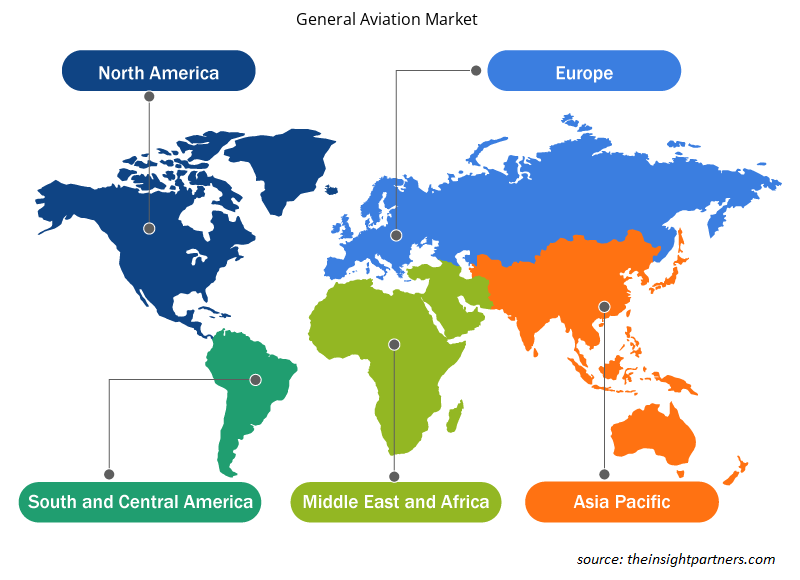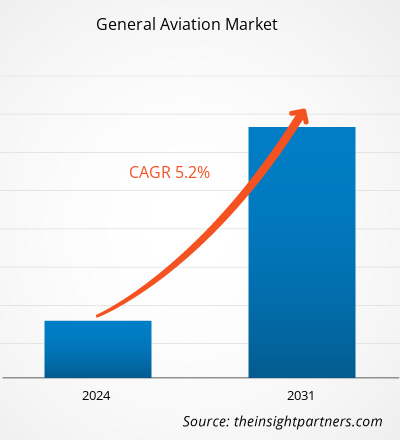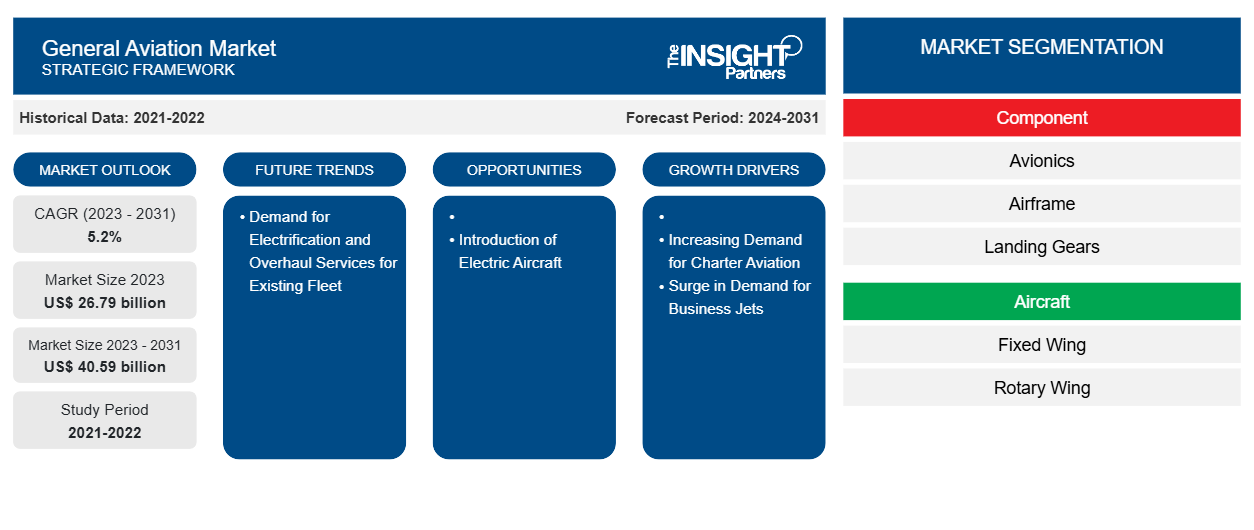Das Marktvolumen der Allgemeinen Luftfahrt wird voraussichtlich von 26,79 Milliarden US-Dollar im Jahr 2023 auf 40,59 Milliarden US-Dollar im Jahr 2031 anwachsen. Der Markt wird voraussichtlich zwischen 2023 und 2031 eine durchschnittliche jährliche Wachstumsrate von 5,2 % verzeichnen. Die Nachfrage nach Elektrifizierungs- und Überholungsdienstleistungen für bestehende Flotten wird voraussichtlich ein wichtiger Trend auf dem Markt der Allgemeinen Luftfahrt bleiben.
Marktanalyse für die allgemeine Luftfahrt
Unternehmen wie Airbus SE, Boeing Company, Bombardier Inc., Dassault Aviation SA, Embraer SA, Pilatus Aircraft Ltd., Gulfstream Aerospace Corporation, Leonardo SpA, Saab AB und Textron Inc. gehören zu den führenden Herstellern im allgemeinen Luftfahrtmarkt. Diese Unternehmen sind mit der Entwicklung, Herstellung und dem Verkauf einer breiten Palette von Flugzeugen an Großhändler beschäftigt, die sie dann an Endverbraucher wie Eigentümer von Privatjets, staatliche Privatfluggesellschaften, Eigentümer von Geschäftsflugzeugen und andere liefern.
Marktübersicht für die Allgemeine Luftfahrt
Das Ökosystem des allgemeinen Luftfahrtmarktes ist vielfältig und entwickelt sich ständig weiter. Seine Interessenvertreter sind Rohstofflieferanten, Komponentenproduzenten, Flugzeughersteller und Endverbraucher. Wichtige Akteure besetzen verschiedene Knotenpunkte des Marktökosystems. Rohstofflieferanten liefern Materialien, darunter Stahl , Gummi und Aluminium, an Komponentenhersteller, die diese dann zur Herstellung und Konstruktion der Endprodukte verwenden. Das Endprodukt wird dann über verschiedene Kanäle an die Flugzeughersteller geliefert, beispielsweise über Direktverkäufe über Unternehmensvertriebshändler oder Drittverkäufe über Drittvertriebshändler. Flugzeughersteller integrieren Flugzeugkomponenten in ihre jeweiligen Flugzeuge.
Passen Sie diesen Bericht Ihren Anforderungen an
Sie erhalten kostenlos individuelle Anpassungen an jedem Bericht, einschließlich Teilen dieses Berichts oder einer Analyse auf Länderebene, eines Excel-Datenpakets sowie tolle Angebote und Rabatte für Start-ups und Universitäten.
- Holen Sie sich die wichtigsten Markttrends aus diesem Bericht.Dieses KOSTENLOSE Beispiel umfasst eine Datenanalyse von Markttrends bis hin zu Schätzungen und Prognosen.
Treiber und Chancen auf dem Markt der Allgemeinen Luftfahrt
Steigende Nachfrage nach Businessjets
Die Popularität und Verbreitung von Businessjets dürfte im nächsten Jahrzehnt zunehmen, vor allem aufgrund der Aufnahme neuer Modelle in den Service. Im asiatisch-pazifischen Raum decken Länder wie China, Japan und Südkorea zusammen jährlich mehr als zwei Drittel der regionalen Nachfrage nach Businessjets und Hubschraubern. Darüber hinaus steigt die Nachfrage nach Businessjets, insbesondere nach großen und mittelgroßen Jets, in Südostasien. Gulfstream, Bombardier und Textron gehören zu den größten Anbietern von Businessjets im asiatisch-pazifischen Raum. Trotz eines Rückgangs der Verkaufszahlen in den letzten zwei Jahren betrachten die Hersteller von Businessjets unter anderem China und Indien als lukrative Märkte.
Einführung von Elektroflugzeugen – eine Chance auf dem Markt der allgemeinen Luftfahrt
Eines der größten Probleme im gesamten Luftfahrtsektor sind die Umweltemissionen, da die globale Luftfahrtindustrie für etwa 2,5 % der weltweiten CO2-Emissionen verantwortlich ist und somit Umweltverschmutzung verursacht. Mehrere Anbieter und Luftfahrtforschungsorganisationen arbeiten an der Entwicklung fortschrittlicher, energieeffizienter und emissionsarmer Flugzeugmodelle, darunter Hybrid- und vollelektrische Flugzeuge . Elektrische Flugzeugsysteme werden von einem oder mehreren Elektromotoren angetrieben, die die Propeller antreiben. Die Stromversorgung kann auf verschiedene Weise erfolgen, am häufigsten durch Batterien. Im Jahr 2021 gab Rolls-Royce den Abschluss seines Jungfernflugs für eine intensive Flugerprobungsphase seines vollelektrischen Flugzeugs bekannt. Nach Angaben des Unternehmens nutzte das Flugzeug einen 400-kW-Elektroantrieb mit dem leistungsstärksten Batteriepaket, das jemals für ein Flugzeug montiert wurde. Schließlich möchte das Unternehmen die Geschwindigkeit des Flugzeugs auf über 300 Meilen pro Stunde steigern, was in einer weiteren Phase in Großbritannien getestet werden soll. Die Entwicklung solcher Flugzeuge wird wahrscheinlich dazu beitragen, die CO2-Emissionen der Luftfahrtindustrie in naher Zukunft zu senken. Daher wird die Entwicklung von Elektroflugzeugen den Akteuren auf dem Markt der allgemeinen Luftfahrt im Prognosezeitraum erhebliche Wachstumschancen bieten.
Segmentierungsanalyse des Marktberichts zur allgemeinen Luftfahrt
Wichtige Segmente, die zur Ableitung der Marktanalyse der allgemeinen Luftfahrt beigetragen haben, sind Komponenten und Flugzeuge.
- Basierend auf den Komponenten ist der Markt der allgemeinen Luftfahrt in Avionik, Flugzeugzelle, Fahrwerke, Triebwerke und Sonstiges unterteilt. Das Triebwerkssegment hatte im Jahr 2023 einen größeren Marktanteil.
- Basierend auf Flugzeugen ist der Markt der allgemeinen Luftfahrt in Starrflügel- und Drehflügelflugzeuge unterteilt. Das Starrflügelsegment hatte im Jahr 2023 einen größeren Marktanteil.
Marktanteilsanalyse der Allgemeinen Luftfahrt nach Geografie
Der geografische Umfang des Marktberichts zur allgemeinen Luftfahrt ist hauptsächlich in fünf Regionen unterteilt: Nordamerika, Asien-Pazifik, Europa, Naher Osten und Afrika sowie Südamerika.
Im Jahr 2023 hatte Nordamerika einen großen Anteil am globalen Markt der allgemeinen Luftfahrt, gefolgt von Europa und dem asiatisch-pazifischen Raum. Heutzutage sind weltweit mehr als 440.000 Flugzeuge der allgemeinen Luftfahrt im Einsatz, von kleinen Trainingsflugzeugen und Hubschraubern bis hin zu interkontinentalen Geschäftsreiseflugzeugen. Etwa 205.000 davon haben ihren Sitz in den USA. In den USA gibt es mehr als 5.100 öffentliche Flughäfen, während weniger als 400 Flughäfen kommerziellen Fluggesellschaften dienen. Die durchschnittliche Passagiermeilenzahl einer Einzelperson in Nordamerika gehört zu den höchsten weltweit. Darüber hinaus dürften die steigende Zahl vermögender Privatpersonen (HNWIs), die verstärkte Betonung der Betriebssicherheit durch Aufsichtsbehörden und die laufenden Fortschritte bei der Entwicklung von Leichtsportflugzeugen das Marktwachstum in dieser Region in den nächsten Jahren fördern.
Regionale Einblicke in den Markt der Allgemeinen Luftfahrt
Die regionalen Trends und Faktoren, die den Markt für die allgemeine Luftfahrt im Prognosezeitraum beeinflussen, wurden von den Analysten von Insight Partners ausführlich erläutert. In diesem Abschnitt werden auch Marktsegmente und Geografien für die allgemeine Luftfahrt in Nordamerika, Europa, im asiatisch-pazifischen Raum, im Nahen Osten und Afrika sowie in Süd- und Mittelamerika erörtert.

- Erhalten Sie regionale Daten zum Markt der allgemeinen Luftfahrt
Umfang des Marktberichts zur Allgemeinen Luftfahrt
| Berichtsattribut | Details |
|---|---|
| Marktgröße im Jahr 2023 | 26,79 Milliarden US-Dollar |
| Marktgröße bis 2031 | 40,59 Milliarden US-Dollar |
| Globale CAGR (2023 - 2031) | 5,2 % |
| Historische Daten | 2021-2022 |
| Prognosezeitraum | 2024–2031 |
| Abgedeckte Segmente | Nach Komponente
|
| Abgedeckte Regionen und Länder | Nordamerika
|
| Marktführer und wichtige Unternehmensprofile |
|
Marktteilnehmerdichte: Der Einfluss auf die Geschäftsdynamik
Der Markt für die allgemeine Luftfahrt wächst rasant. Dies wird durch die steigende Nachfrage der Endnutzer aufgrund von Faktoren wie sich entwickelnden Verbraucherpräferenzen, technologischen Fortschritten und einem größeren Bewusstsein für die Vorteile des Produkts vorangetrieben. Mit der steigenden Nachfrage erweitern Unternehmen ihr Angebot, entwickeln Innovationen, um die Bedürfnisse der Verbraucher zu erfüllen, und nutzen neue Trends, was das Marktwachstum weiter ankurbelt.
Die Marktteilnehmerdichte bezieht sich auf die Verteilung der Firmen oder Unternehmen, die in einem bestimmten Markt oder einer bestimmten Branche tätig sind. Sie gibt an, wie viele Wettbewerber (Marktteilnehmer) in einem bestimmten Marktraum im Verhältnis zu seiner Größe oder seinem gesamten Marktwert präsent sind.
Die wichtigsten auf dem Markt der Allgemeinen Luftfahrt tätigen Unternehmen sind:
- Airbus
- Boeing
- Leonardo SpA
- Saab AB
- Dassault Aviation
- PILATUS AIRCRAFT LTD
Haftungsausschluss : Die oben aufgeführten Unternehmen sind nicht in einer bestimmten Reihenfolge aufgeführt.

- Überblick über die wichtigsten Akteure auf dem Markt der Allgemeinen Luftfahrt
Neuigkeiten und aktuelle Entwicklungen auf dem Markt der Allgemeinen Luftfahrt
Der Markt für die allgemeine Luftfahrt wird durch die Erhebung qualitativer und quantitativer Daten nach Primär- und Sekundärforschung bewertet, die wichtige Unternehmensveröffentlichungen, Verbandsdaten und Datenbanken umfasst. Im Folgenden finden Sie eine Liste der Entwicklungen auf dem Markt für Innovationen, Geschäftserweiterungen und Strategien:
- Im Jahr 2024 hat Lyte Aviation eine 19-sitzige Version seines wasserstoffelektrischen VTOL-Flugzeugs LA-44 eingeführt, die sich an Geschäfts- und Privatluftfahrtnutzer richtet. (Quelle: Lyte Aviation, Pressemitteilung)
- Im Jahr 2021 stellte Bombardier den neuen super-mittelgroßen Businessjet Challenger 3500 vor, dessen Standard-Avioniksysteme Auto Throttle, Smart Link Plus und Voice Activated Cabin System umfassen. (Quelle: Bombardier, Newsletter)
Marktbericht zur Allgemeinen Luftfahrt – Abdeckung und Ergebnisse
Der Bericht „Marktgröße und Prognose der Allgemeinen Luftfahrt (2021–2031)“ bietet eine detaillierte Analyse des Marktes, die die folgenden Bereiche abdeckt:
- Größe und Prognose des Marktes für die allgemeine Luftfahrt auf globaler, regionaler und Länderebene für alle wichtigen Marktsegmente, die im Rahmen des Berichts abgedeckt sind
- Marktdynamik wie Treiber, Beschränkungen und wichtige Chancen
- Markttrends für die Allgemeine Luftfahrt
- Detaillierte Porters Fünf Kräfte
- Marktanalyse für die allgemeine Luftfahrt, die wichtige Markttrends, globale und regionale Rahmenbedingungen, wichtige Akteure, Vorschriften und aktuelle Marktentwicklungen umfasst
- Branchenumfeld und Wettbewerbsanalyse der Allgemeinen Luftfahrt, einschließlich Marktkonzentration, Heatmap-Analyse, prominenten Akteuren und aktuellen Entwicklungen
- Detaillierte Firmenprofile
- Historische Analyse (2 Jahre), Basisjahr, Prognose (7 Jahre) mit CAGR
- PEST- und SWOT-Analyse
- Marktgröße Wert/Volumen – Global, Regional, Land
- Branchen- und Wettbewerbslandschaft
- Excel-Datensatz
Aktuelle Berichte
Erfahrungsberichte
Grund zum Kauf
- Fundierte Entscheidungsfindung
- Marktdynamik verstehen
- Wettbewerbsanalyse
- Kundeneinblicke
- Marktprognosen
- Risikominimierung
- Strategische Planung
- Investitionsbegründung
- Identifizierung neuer Märkte
- Verbesserung von Marketingstrategien
- Steigerung der Betriebseffizienz
- Anpassung an regulatorische Trends





















 Kostenlose Probe anfordern für - Markt für die allgemeine Luftfahrt
Kostenlose Probe anfordern für - Markt für die allgemeine Luftfahrt